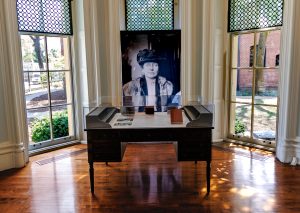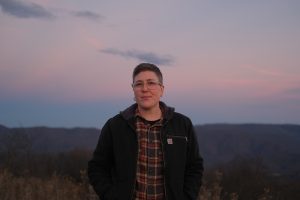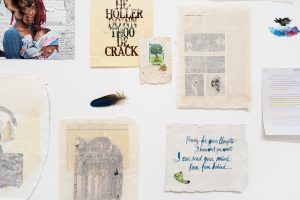This is the first interview of “In House,” an oral history series entering the places that house books across Chicago. Sections of this interview have been edited for length and clarity.
I first heard the rumor from a fellow reader who in turn heard it from another reader (word travels fast amongst readers): Pilsen Community Books was for sale. On July 19, the owners of the three-year-old bookstore broke the news to devotees, explaining their decision to focus on their other bookstore, The Dial, and also announcing prospects of a buyer. The future, however, was uncertain.
When Mary Gibbons and Aaron Lippelt opened Pilsen Community Books (PCB) in February 2016 at 1102 W. 18th St., they filled a need on the Lower West Side not only for a bookstore but for a place to host literary events and local publications, a place to connect. In a “triple-secret unofficial” email correspondence from PCB employee Manuel Morales y Méndez, Méndez celebrated one such connection between a young writer and artist whose meeting at PCB led to a collaboration for the writer’s first published piece in a local zine, which would later be sold at the store.
A few months after the initial announcement, on October 15, Gibbons and Lippelt released the names of the new owners, at once dispelling the fear of losing the community center. Experienced Chicago booksellers Katharine Solheim, Mandy Medley, and Thomas Flynn will take the keys next spring, and Gibbons and Lippelt will continue running their sister store, The Dial, in the Loop.
The PCB development coincides with a changing tide for bookstores in the area. Librería Girón, the only Spanish-language bookstore left in Chicago after the closure of Irving Park’s Tres Amerícas, shut its flagship store on 18th Street in 2017 due to rising property taxes and now operates out of its Little Village locations. This past August, Malia Haines-Stewart and Alan Medina incorporated the bookshop Inga into their popular cine-club space filmfront on 18th Street. One street over, Open Books Pilsen acquired 3,000 books from Pablo Helguera’s Librería Donceles in 2018 as an ongoing legacy project of the Spanish-language traveling bookstore/art installation.
Before PCB officially changes hands in the spring, I visited 18th Street to speak with Gibbons, with occasional interludes by customers, including one who bought a set of Roald Dahl stories for their boyfriend who, they said, bears a striking resemblance to Mr. Twit. We continued on to discuss the history of PCB before it enters its new era.

Amanda Dee: How long have you been in Chicago?
Mary Gibbons: I moved to Chicago in 2009, so 10 years. I’ve lived here [in Pilsen] for about eight years. I just moved to Bridgeport, so not too far away.
AD: What was the draw to open Pilsen Community Books? Since you were living in the area, was it a simple decision to open it here? Or was there a specific draw to open it in in this neighborhood?
MG: It was partly because I was living here, but it was more so because I knew there weren’t many bookstores here. Aaron [Lippelt] and I worked at a literacy nonprofit called Open Books, and they have a warehouse in Pilsen where they operate their online store. We were in charge of the online sales. It’s a pretty big operation, but they get so many donations that there’s always so many books. So we opened a discount store inside of Open Books, and it got a really great response from the community. We talked a lot about, What would we do if we had a real store? How would we set it up? And then, we were kind of like, Why don’t we just do it? We would have done it through Open Books, but it’s not really their game: they were more into the service aspect. We already knew that Pilsen was open to it, and it was really affordable rent at the time. And we said, If we find a place, then we’ll do it. Then we did find a place, this place.

AD: Before you started working at Open Books, you were pursuing a Ph.D. program in literature at the University of Chicago. Then, about four years in, you left the program to pursue more community work. How important was that community connection when you were opening this bookstore?
MG: It was a huge part of what we wanted to do. We didn’t ever want it to be our main focus, because we really wanted to create a business that was sustainable, so we said, Any way we can give back to the community, we will try to do that. But we did want it to be a part of it: the community supports us, we try to support the community. We started off thinking we would kind of follow in Open Books’ footsteps and give used books to schools, but we just do not get the same volume of donations as they did so we could never give out that many used books.
And after doing a few giveaways [Pilsen Reads!], we noticed that teachers need specific things. If you give them books, they really appreciate it, but it’s more helpful if they can choose what they get. So, we switched it: teachers make a wish list of the books they want for their classroom and then we buy them. They get a smaller donation, but each book is something they need so it goes a long way.

AD: In your mission statement, you talk about how you want Pilsen Community Books to be more than just a bookstore. Besides giving back to the community, what do you mean by that?
MG: That was the main thing, really. Do that, have community events, grow in relationship to the community instead of just existing in it. When we first started, we had hoped that we would go more into programming, but we found that running the bookstore took more time – it’s all we do. So we dialed back our expectations and focused on the book giveaways and events like story times. When we opened up our second store [The Dial], we literally had no time for any of that stuff. So that’s why we picked owners who are dedicated to that.
AD: I came across the video you did for The Atlantic’s Re: Think series, where you talked about the reclaimed bleacher wood that you chose for the floor-to-ceiling bookshelves – how did that care go into opening the store?
MG: Personally, we enjoy looking at beautifully made objects. But also we understood that we were competing with Amazon. And there are ways in which you will never be able to compete with Amazon – I mean, they have everything, and always for cheaper than what you can offer it for. But the one thing we could create that they can’t is a pleasant space to spend time in, by choosing beautifully made books and furniture, because there are fewer and fewer of those [spaces], especially in retail.

AD: Besides finding beautiful books, how do you curate the books that you’re selling?
MG: A lot of that is just listening to what people ask for or noticing what people buy. In both stores, people buy different things. There’s some overlap, obviously, but there are things at The Dial that we sell a ton of over there, but we never sell here; and then there are things we sell here that we never sell over there. And all the sections are slightly different. Just listening to what people request, books that they’re buying all the time –just noticing, mainly.
AD: What’s a difference between the stock here in Pilsen and at The Dial?
MG: We sell way more sociology over here than we do at The Dial. That’s the biggest difference. We did make a huge sociology section over there because it sells so well over here, but then it didn’t sell very well. There are more kids books over here, because there are more families. Even the types of classics we sell over there are different. For instance, we can’t keep Little Women on the shelf over there, but we don’t really sell it over here.
AD: Through what channels do you find the hyperlocal selections for this store? Like the zines and things that are harder to track down?
MG: People come in, ask if they want us to sell their book, and we say yes or no. In the beginning, we took a lot more stuff on consignment. And as much as we want to take everything, not everything sells, so now we have a better sense of the stuff that will sell in the store. Manuel [Morales y Méndez], who works in the evenings, he is probably the best at doing that work – he’s more of our community builder. Aaron and I feel more comfortable behind the scenes, so he’s built a lot of relationships with local authors.
AD: If you could pick a couple moments from this store’s history, which would be most important?
MG: I would say one of them is definitely the book fair that we put on last year [in 2018] in Bridgeport. We had a storage unit filled with books, so we decided to sell them at a discount. We got a bunch of bands and local artists to make book-related art; it was awesome. A lot of people came out.



Image: Artwork for Pilsen Community Books events: Marcovaldo, or the Seasons in the City print by Liana Jegers; Pilsen Community Books First Annual Fair print by Shelby Rodeffer; Tortilla Flat print by Clay Hickson. Photos courtesy of Mary Gibbons.
Another one of my favorite events that we did was with Eve Ewing. She was really one of our most dynamic guests. She was really good at talking about her work, just talking in general, and we had a really good crowd for it.
And before we opened the store, we were selling books out of a loft where we kept our overstock and processed books. When we signed our lease in winter of 2015, we were promised a move-in date of April 1, 2015. We quit our jobs in March to be ready for a summer opening. Turns out we knew very little about building and construction in a big city and were not prepared for the nine-month delay in the renovation of the building.
So in that time when we were [in the loft], we really needed to make a little money and get the word out that we were opening, so we opened up for 2nd Fridays there. We still get people coming in here like, Were you those people at 2nd Fridays?
When we could finally move into the space in January of 2016, we were so desperate for money that we had to work our butts off to get the space ready in just a few weeks. So, when we finally opened after a nine-month, unemployed waiting period and a marathon few weeks of building the store, it felt like a big feat. We had so many people who had been following our progress show up on that first night. It was an incredibly warm welcome after a pretty grueling year, so I’ll never forget that night!
AD: Do you think the community is what you’ll miss most about not having PCB?
MG: Definitely. We have amazing regulars, just an incredible group of people that come in here all the time. I will definitely miss that. We chose to keep the other one because it’s simpler to operate. This one we love, and it’s the first one we opened, but it’s open longer hours and it requires more staff.
AD: And what advice do you have for the next set of hands?
MG: I think one good way of making a store that works for a lot of people is partly to make a store that you really like; focus on your interests because then you’ll do a better job of it. There are areas of this store like sci-fi – neither of us really know sci-fi, and we never will, and that’s okay. There are other people who have stores that focus on sci-fi. So I guess leaning in to the things that you’re really good at, so the store will have its own character. That’s what you want, anyway. Because there are a lot of bookstores in the city. But [the new owners] are going to do great; they know what they’re doing.

Amanda Dee is a Chicago-based multi-media creator with seven years of storytelling experience across art, journalism, nonprofit, and health organizations. She is also the associate producer of the oral history podcast Moral Courage Radio: Ferguson Voices, which documents voices from the Ferguson community in the wake of the 2014 police shooting of Michael Brown. You can find more of her work here.






